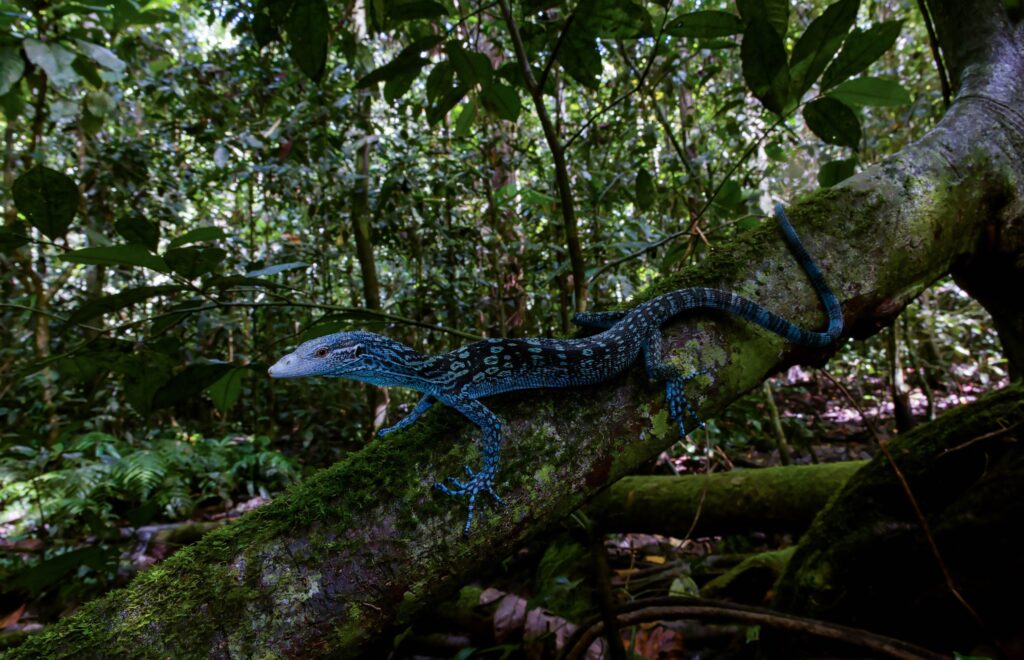12 Jul
The blue tree monitor (Varanus macraei) is a reptile doused in mystery. Only officially described in 2001, the “blue lizard of Batanta” has historical ties with the people of Raja Ampat and now, international interest in the herpteculture hobby has strengthened those ties even further. Since its discovery, the blue tree monitor has been subject to extensive export in line with quotas set by the Indonesian government. Data and research on the sustainability of this harvest are limited, but as V. macraei has one of the smallest distributions of all Varanids (measuring just over 455km2) conservationists are concerned. While the UK and Europe are on the cusp of telling a successful tale of captive breeding efforts resulting in reduced demand for wild-caught monitors, the rest of the world is yet to catch up. Experienced Varanid breeder, Chris Applin recently visited the remote island of Batanta to understand how these animals live in the wild and the complicated politics around their collection.
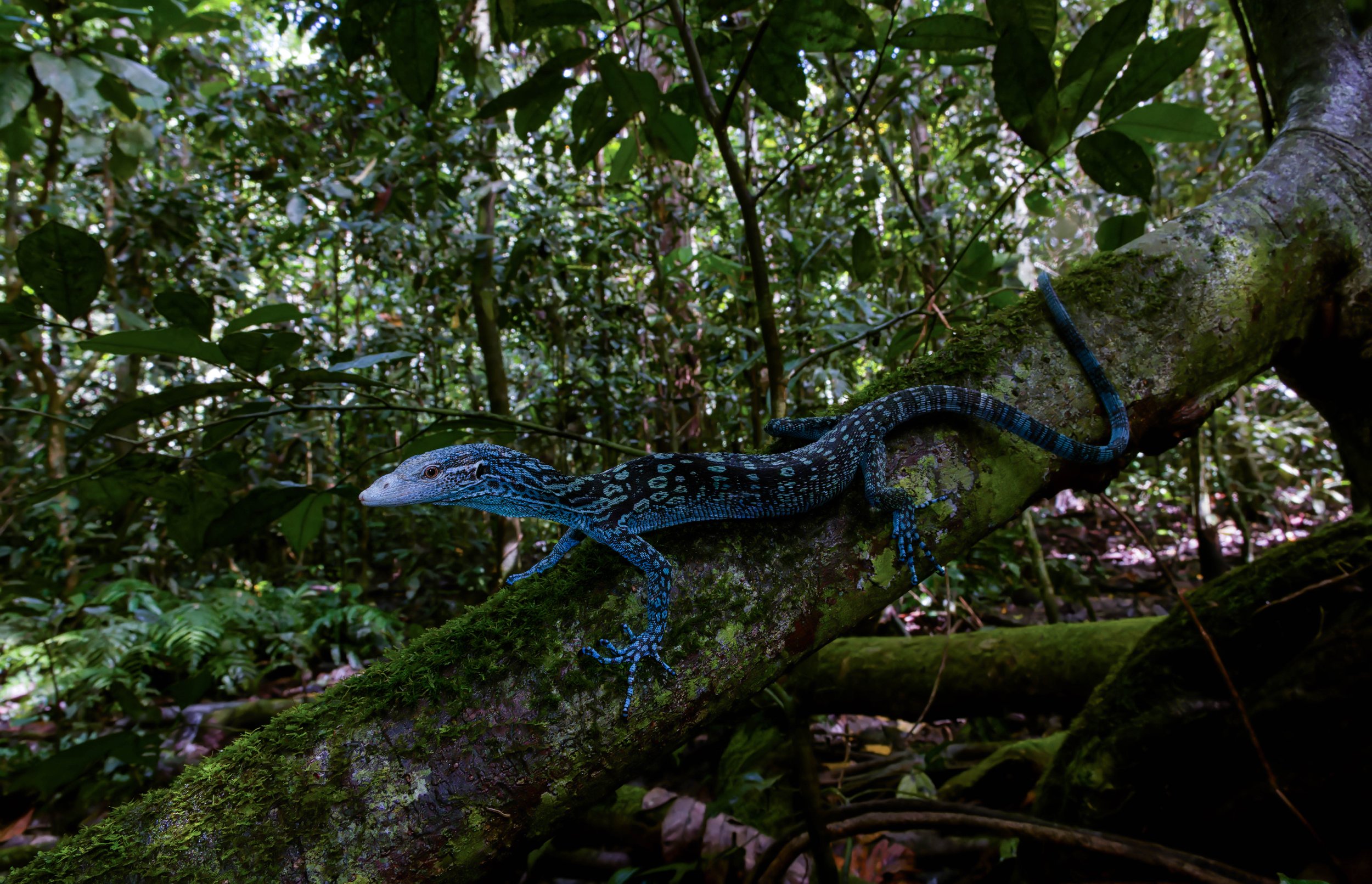
The Raja Ampat Islands
The islands of Raja Ampat off the coast of West Papua are home to a dizzying array of species. Situated in the heart of Wallacea, these islands have seen incredible speciation over millions of years. Raja Ampat is particularly famous for its birds of paradise (Paradisaeidae), of which each island has a very distinct and beautifully coloured species with unique mating behaviours. Like the birds of paradise, the tree monitors (Hapturosaurus) of the region also exhibit unique colours, behaviours and species. Each island in Raja Ampat is home to a different member of the “prasinus complex”, a term coined to differentiate the many species previously thought to be synonymous with the green tree monitor (Varanus prasinus). The blue tree monitor is found on Batanta, the yellow tree monitor (V. reisengeri) is found on Misool, the golden-spotted tree monitor (V. boehmi) is found on Waigeo and the green tree monitor (V. prasinus) is found on Salawati and mainland New Guinea.
Because Raja Ampat has gained a reputation for its bird life and excellent diving, the town of Sorong acts as a gateway for tourists. It is the largest city in the Indonesian province of West Papua. It also acts as a harbour port for Indonesia’s oil and gas trade and hosts a domestic airport connecting Papua to the rest of the archipelago. Sorong is also famous for several localities/forms of species that are well-established in the pet trade such as the “Sorong” green tree python (Morelia viridis) and “Sorong bar neck” scrub python (Simalia amithistina). Part of this is due to the easy harvesting and export of local fauna from the region surrounding the city. Once exporters in Sorong heard about the “blue lizards” of Batanta, their attention soon turned towards Varanus macraei.

The international trade of macraei
Blue tree monitors have been sought-after in private collections since their discovery. Their alluring colouration and remarkable cognitive ability make them very appealing pets. After a few specimens were successfully exported to the US in the early 00s, a snowball effect began to form.
Chris explains: “The story of the macraei is that people on Batanta showed my friend, Nurdin, a blue monitor they had caught whilst he was helping a film crew look for Crocodile monitors in the late 90s. This was the first time anybody from outside Batanta had seen Varanus macraei. He told of this monitor to a German friend of his, Manfred Resinger, who later led an expedition to collect the first macraei. Shortly after, a collector in Sorong heard about this and so they sent some hunters from the Aru Islands who had already been collecting the black tree monitors to the town of Amdui in Batanta. These hunters began training the local people how to catch the macraei and make money. Now, there are about 30 guys in Amdui that rely on the collection of blue tree monitors for their income.”
The species was officially described later in 2001. The name macraei is in honour of herpetologist, Duncan Macrae who founded the Bali Reptile Park and is thought to be the first person to export the species to the USA.
International laws such as CITES regulations are implemented to protect endangered species. Varanus macraei is listed as an Appendix 2 species under CITES regulations. This means that their trade is restricted to certain export quotas and paperwork. In recent years, these quotas only permit the sale of captive-bred individuals.
The collectors sell the lizards to exporters in Sorong at around £30 per lizard. They are then shipped from Sorong to Jakarta.
“The farms in Jakarta should be captive breeding them for export,” adds Chris. “However, it has been suggested that some of the farms might be laundering lizards through as captive-bred. This has been shown with green tree pythons in a paper by Jessica A. Lyons and Daniel J.D. Natusch (Wildlife laundering through breeding farms: Illegal harvest, population declines and a means of regulating the trade of green pythons (Morelia viridis) from Indonesia). The idea is that they should be getting some wild-caught breeding stock together and breeding them in the farms and producing F2 stock for export and only collecting wild-caught animals occasionally to repopulate their breeding stock”.
A recent paper (Mating behavior and breeding of the blue tree monitor, varanus macraei in an in-country facility in indonesia: a preliminary note by Beny Rahmanto et al) has shown that one of the leading farms in Jakarta has documented the captive breeding of Varanus macraei. Hopefully, their knowledge can be passed on to others to help propagate the species in Indonesia.
Europe only permits the import of juvenile tree monitors under a specific size to help ensure that the animals have been truly captive bred.
Chris continues: “Before the macraei harvesting they were pearl farming and then some logging in the early 2000s. If you speak to the older generations in Amdui, they do care about the lizards. They don’t want to have to tell their grandkids about the blue lizard they used to have. Plus, this is their main source of income. I told them that if CITES say tomorrow that they are Appendix 1, there will be no legal trade anyway.”
Cutting the legal trade of animals can sometimes result in increased poaching and smuggling. The animals often increase in value, creating higher stakes for hunters and buyers. As the entire chain is moved “underground”, it may also encourage other crimes in the region.
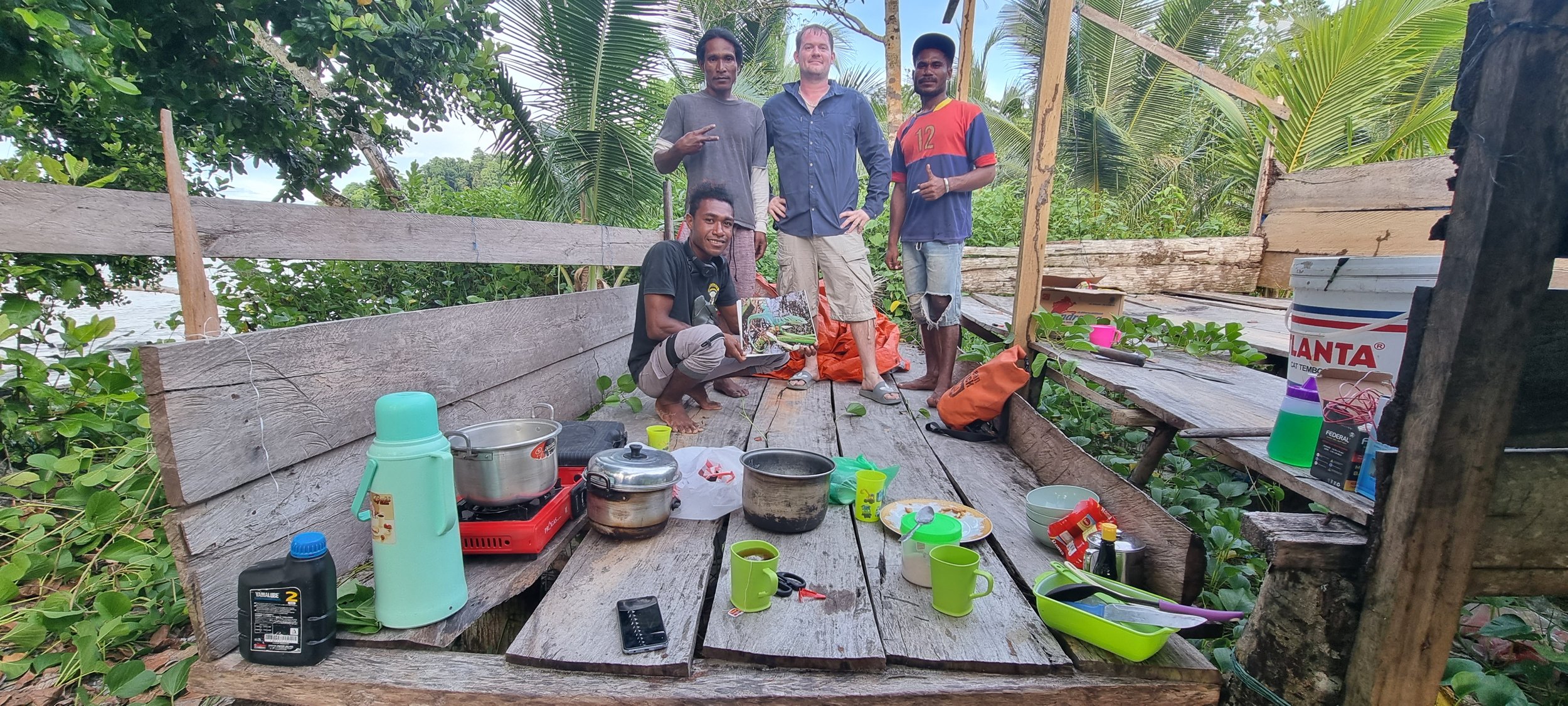
On the ground in Batanta
Chris visited Batanta with a local guide named Nurdin Ohorella, who had previously led a range of expeditions and helped to lobby against the illegal logging that was happening in Raja Ampat in the early 2000s. Nurdin was present when the first reports of macraei were passed onto the collectors in Sorong and now feels dutybound to show tourists the lizards as a more sustainable alternative to the wild collection.
“The flight time was around two days. I went from London to Dubai, Dubai to Jakarta and Jakarta to Sorong. Here, I met Nurdin and we caught a ferry to Waigeo, where we chartered a longboat. Less than an hour later we were on our way to Batanta.”
Chris keeps and breeds a variety of tree monitor species and is thought to be the first person in the UK to successfully breed Varanus reisengeri, the yellow tree monitor. Having previously visited Australia several times to find and photograph Varanids, the trip to Batanta is the first step towards Chris’ goal of publishing a book on the prasinus complex and photographing every species in the wild. “My thoughts before I went there was that the locals should stop collecting them altogether” explains Chris. “We’ve had so many exported into private collections that the trade doesn’t need any more! They’re breeding really well in Europe and there’s just not the need. But, after visiting, I’m kind of in the middle. They’re very poor so you can’t stop them from doing it and the alternative is logging or over-collecting from specific locations. I hoped to educate the locals on the sustainable collection and the long-term goal would be getting them to start breeding them in situ.”
Existing literature reports on local extinctions of blue tree monitors, which paints a very worrying picture for the species. Herpetological hearsay also produced a rumour that macraei were already extinct, partly because the original species description came from a captive specimen and exports dramatically reduced in recent years due to covid. Both claims are now proven to be false.
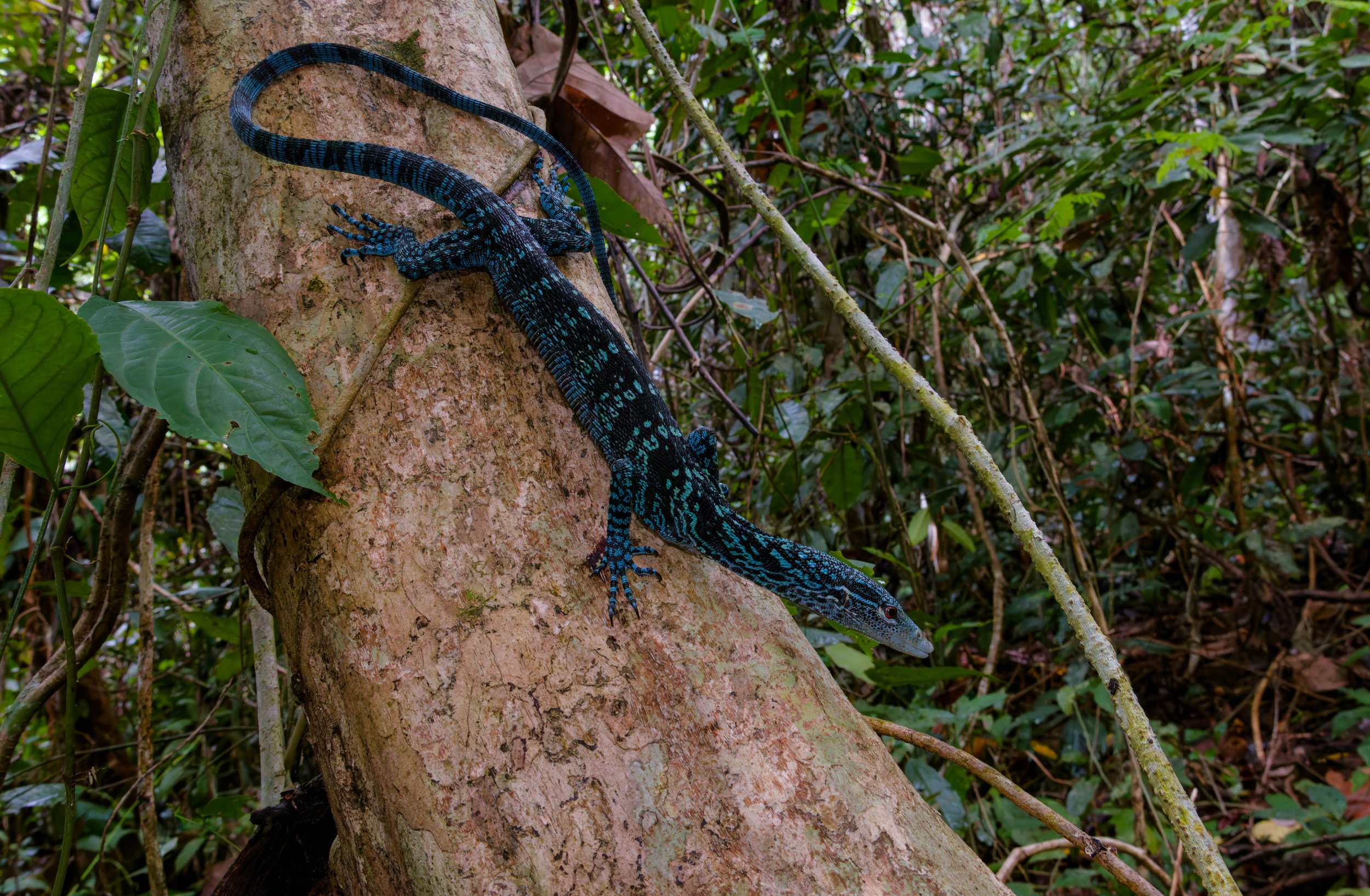
Chris continues: “Back in 2000, they were catching the blue tree monitors in the village of Amdui. Since then, they have taken down some of the forest and replaced it with bananas and coconut trees to sustain themselves. This is where it’s conflicted when we talk about local extinctions. Indeed, the monitors can’t be found in Amdui anymore, but 10 minutes away we did manage to find two in the space of an hour.”
Chris and Nurdin joined a team of two hunters and found one or two blue tree monitors each day. He slept in the camps that the local people would typically use when harvesting the monitor lizards, establishing small huts in locations that have a fruitful population of lizards. “Because the centre of Batanta is extremely steep and mountainous, the locals will only collect from around the coast where it’s easy to access,” adds Chris. The terrain of Batanta may award some form of protection from over-exploitation. On “good days” a group of five hunters can collect up to 10 individuals per excursion. The hunters are given an order from Sorong to collect X amount of macraei, reisingeri or boehmi and they will then visit the corresponding island, adopting the same hunting strategies to catch all lizards – a bamboo pole with a noose on the end known locally as a Gancho and scale the trees barefooted.
“They rarely visit Misool because it is so far away,” Chris says. “Misool is perhaps a five-hour ferry, so they don’t collect nearly as many yellow tree monitors as they do for the other species.”
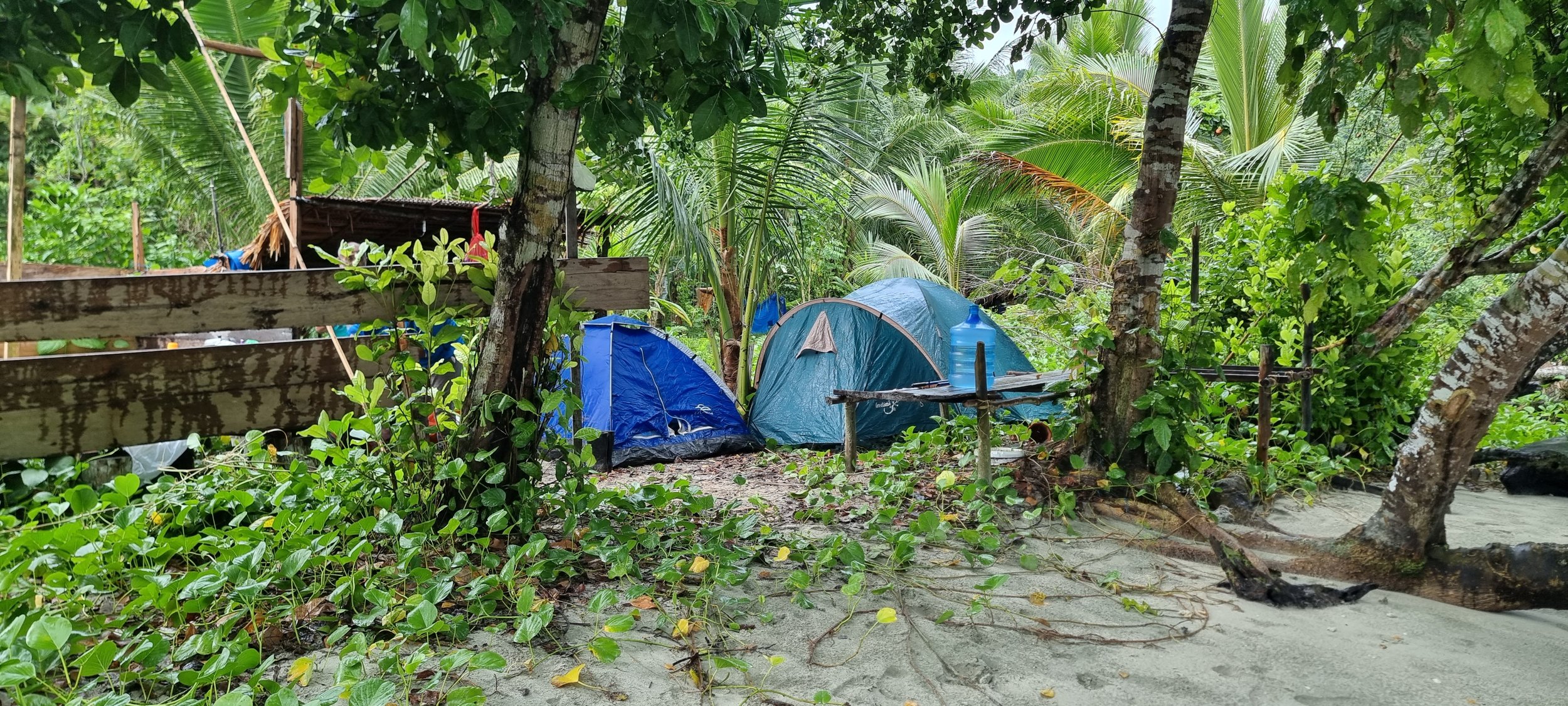
Sustainability of wild collecting
If international laws were abided by, only a few blue tree monitors would need to be collected from the wild. Hobbyists now know how to breed the species with great success and even though they are far too expensive for most keepers, dedicated Varanid enthusiasts (who are also most likely to contribute to breeding efforts) can frequently source them. Unfortunately, harvesting has now become the only method of income for many families in Amdui. A ban could not only drop them further below the poverty line but potentially cause a scenario where people must exploit other natural resources to feed their families. Chris is working closely with Nurdin and some tour companies to promote the concept of eco-tourism.
“Raja Ampat is already geared up for eco-tourism because of the endemic species of birds of paradise,” Chris explains. “The infrastructure is there and there’s even a pretty good ferry system between the islands. I was discussing with the local people in Amdui about the idea of setting up a homestay and allowing people to visit the island to see the monitor lizards more frequently. It’s just a pipedream now, but they seemed keen to set something up. When I visited, I would pay the hunters daily no matter if we found anything or not, plus a tip for each lizard that we found. I would give each hunter the equivalent of the price of a lizard to photograph the monitors and release them afterwards. If a few groups of people did that a few times a year, it wouldn’t be long before the people in Batanta think it’s better to leave the lizards alone and have a better chance of spotting them with tourists.”
This model has worked in various places across the world. Some endemic Dendrobatids in Colombia and Northern Peru are protected by tourists as locals are incentivised to preserve the habitat and even use artificial breeding pools to support the reproduction of frogs. Costa Rica incentivised land owners to grow rainforests by investing heavily in tourism infrastructure and providing government grants. While it might be a long time before Indonesia adopts a model like that, information can be passed on to locals about the value of their natural resources. “They were absolutely shocked that anyone was even breeding the monitors outside of Indonesia,” Chris says. “They only see the smaller picture, just up until they hand over the lizards in Sorong. When they heard that people dedicate their lives to studying and breeding them, they were shocked. Some of them even suggested that they breed them on the island in situ! They are protective of the monitors and they certainly don’t want to see them disappear, but they are also extremely poor and can only just live off the land. The money from the monitor lizards helps them with anything else that they need.”
Although blue tree monitors are the most encountered Varanids on Batanta, there are several other species local to the area that is frequently seen in the pet trade. Peach-throat monitors (V. jobiensis), mangrove monitors (V. indicus), blue-tailed monitors (V. doreanus) and the occasional crocodile monitor (V. salvadorii) are also collected from the island. Without scientific research assessing the impact of exports, some of these animals may be more threatened than others and sadly, harvesting animals from remote locations may be to the detriment of the ecosystem or the individual species occupying it. Some species are also targeted more than others.
Chris adds: “I also spotted an emerald tree skink (Lamprolepis smaragdina). The collectors didn’t know much about them, which surprised me. They had never collected them and never really looked for them even though they are quite popular in the pet trade and make a good captive. They’re also absolutely petrified of snakes out there. They have green tree pythons (Morelia viridis) all over that range and they’re just not interested in collecting them. We found a Candoia boa (Candoia carinata), and no-one would touch it. The hunters just went white with fear. They have small-eyed snakes (Micropechis ikaheca) over there that are super venomous, so I think they treat every snake like it’s ikaheca. Which is probably sensible.”
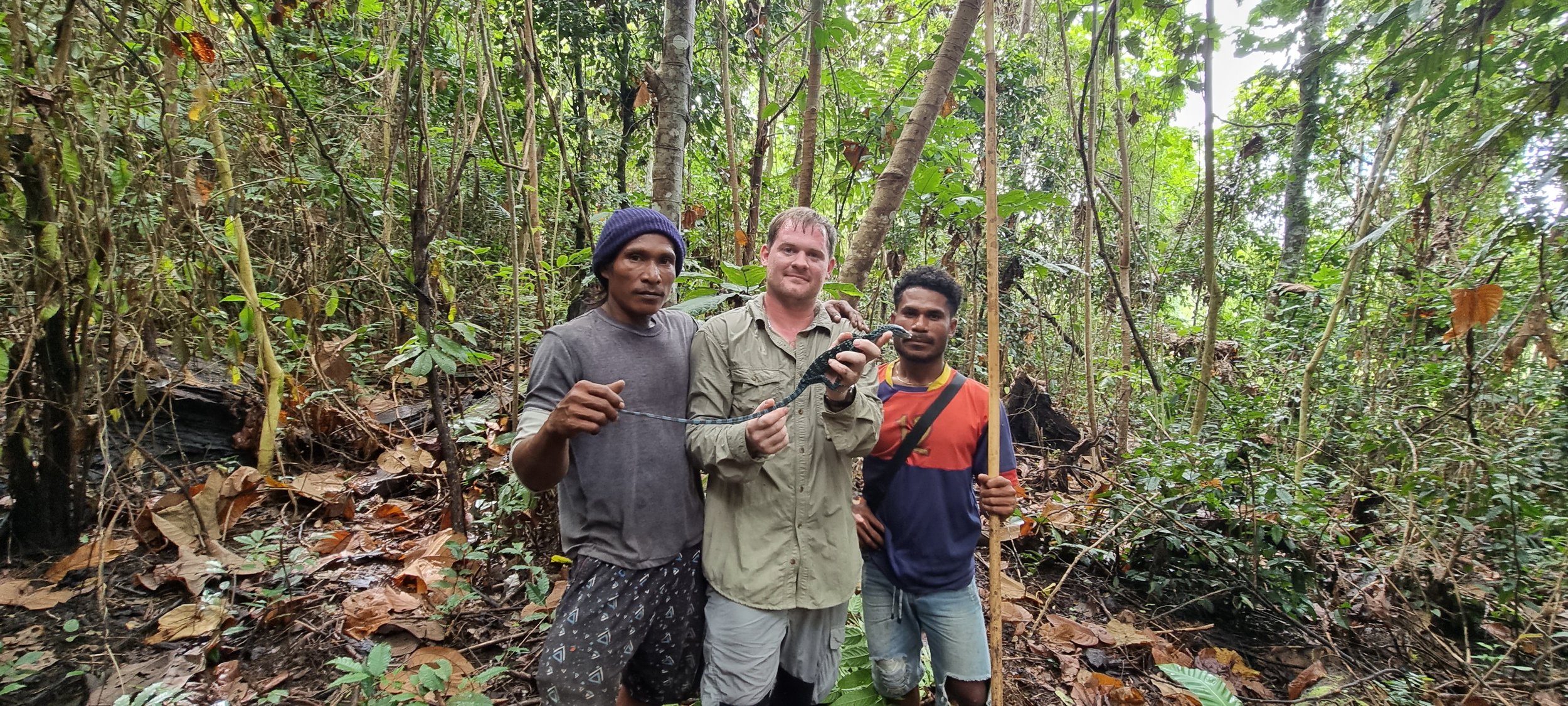
Macraei behaviours in the wild
Chris has been keeping Varanids for 20 years and tree monitors for 15. Over that time, he has successfully bred V. prasinus, V. beccarii and is thought to be the first person in the UK to successfully breed V. reisengeri. His trip to Batanta will therefore be used to inform his husbandry practices for other tree monitors while also sharing important information with fellow keepers and breeders. He found that the lizards were most active between the hours of 8am and 3pm. They emerge in the morning from their taller roosting trees and descend to the smaller trees to bask and hunt for insects. “If there has been a rainstorm in the afternoon and it suddenly gets sunny again, the monitors will stay out later,” explains Chris. “They are most active after rain, especially if it rains the night before or in the early morning. I think this probably forces them to come out and seek the sun to bask. By contrast, salvadorii are only active when it’s been extremely sunny all day. If it’s rained, they rarely find them.”
“The locals in Batanta believe the tree monitors only eat locusts and katydids. No frogs or rodents or chicks or anything. They’ve had them regurgitate and it’s always just been insects. There are loads of land crabs all over Batanta so I can’t see that if a lizard could get hold of a crab, they wouldn’t eat it, but the hunters say it’s only ever insects that they hunt in the canopies. The lizards leave their resting places on larger trees to hunt on smaller trees that have lots of sunlight where the insects are gathering and they just pick them off up there.”
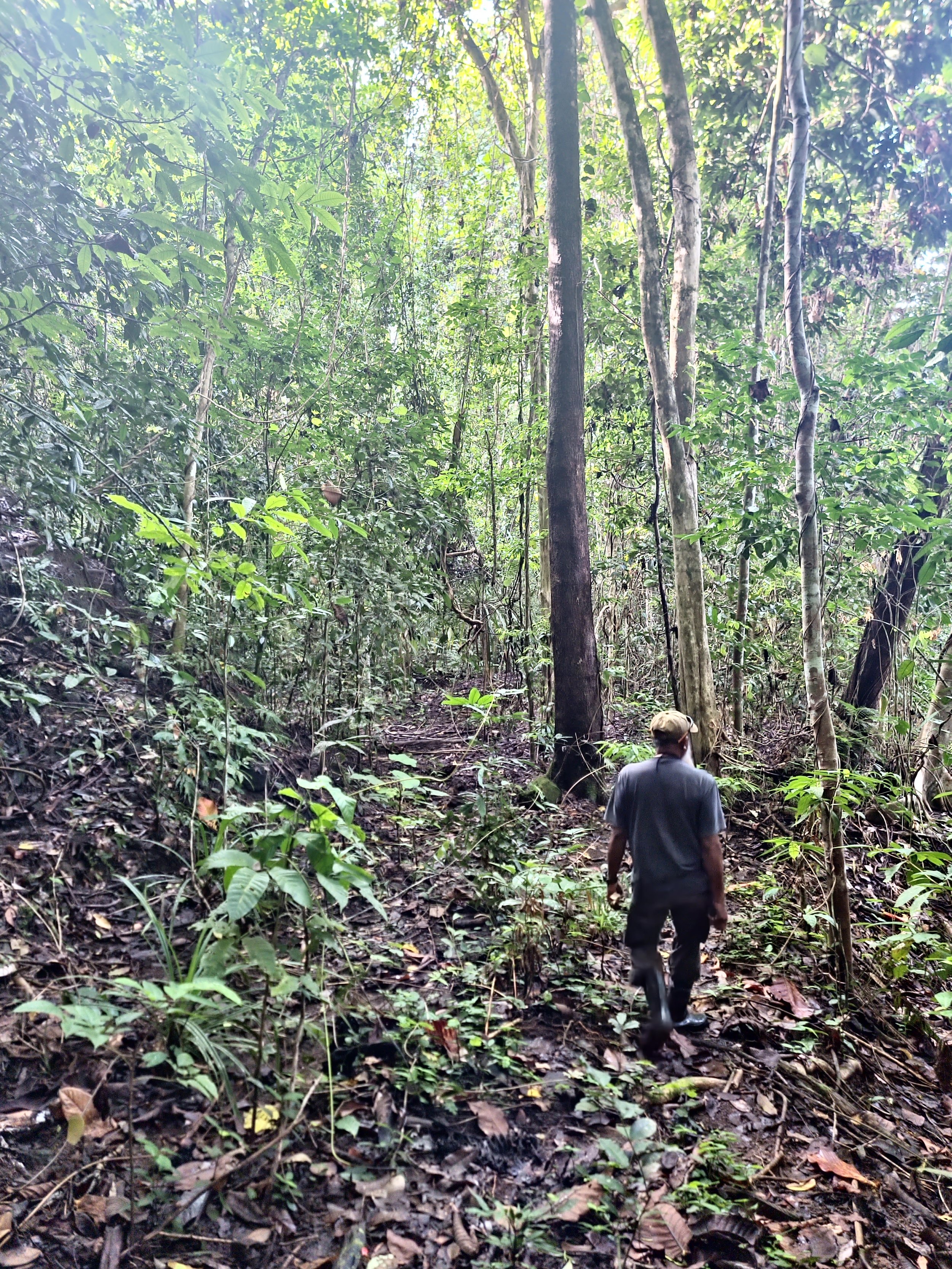
He also took some UVI readings whilst there. The trip was in November, just outside of the rainy season and therefore it is problematic to use one week’s worth of data to guide best husbandry practices. However, the information that he did gather only reinforced existing literature on the topic.
Chris continues: “They’re getting as low as zero under the canopy but up to six where they’re hunting. Average readings were between two and three which is pretty much what keepers are providing them anyway. I was keeping my tree monitors a lot drier than they would be in the wild. Since visiting Batanta and experiencing +85% humidity every day, I’ve turned all the misting systems back on. It rained every single day we were there and we were there in the dry season. The average ambient temperature during the day was 28°C, dropping to 25°C at night. The highest daytime temperature was 32°C.”
“I’ve had my tree monitors breeding for four years now so I’m a little apprehensive to change things too much. However, I am now trying to implement live plants although this is proving difficult with monitor lizards due to their larger size. I wasn’t using leaf litter before but while trekking through the forest in Batanta, I noticed there are lots and lots of layers of leaf litter. Adding this has provided some great enrichment for my monitors who love hunting for insects hiding within.”
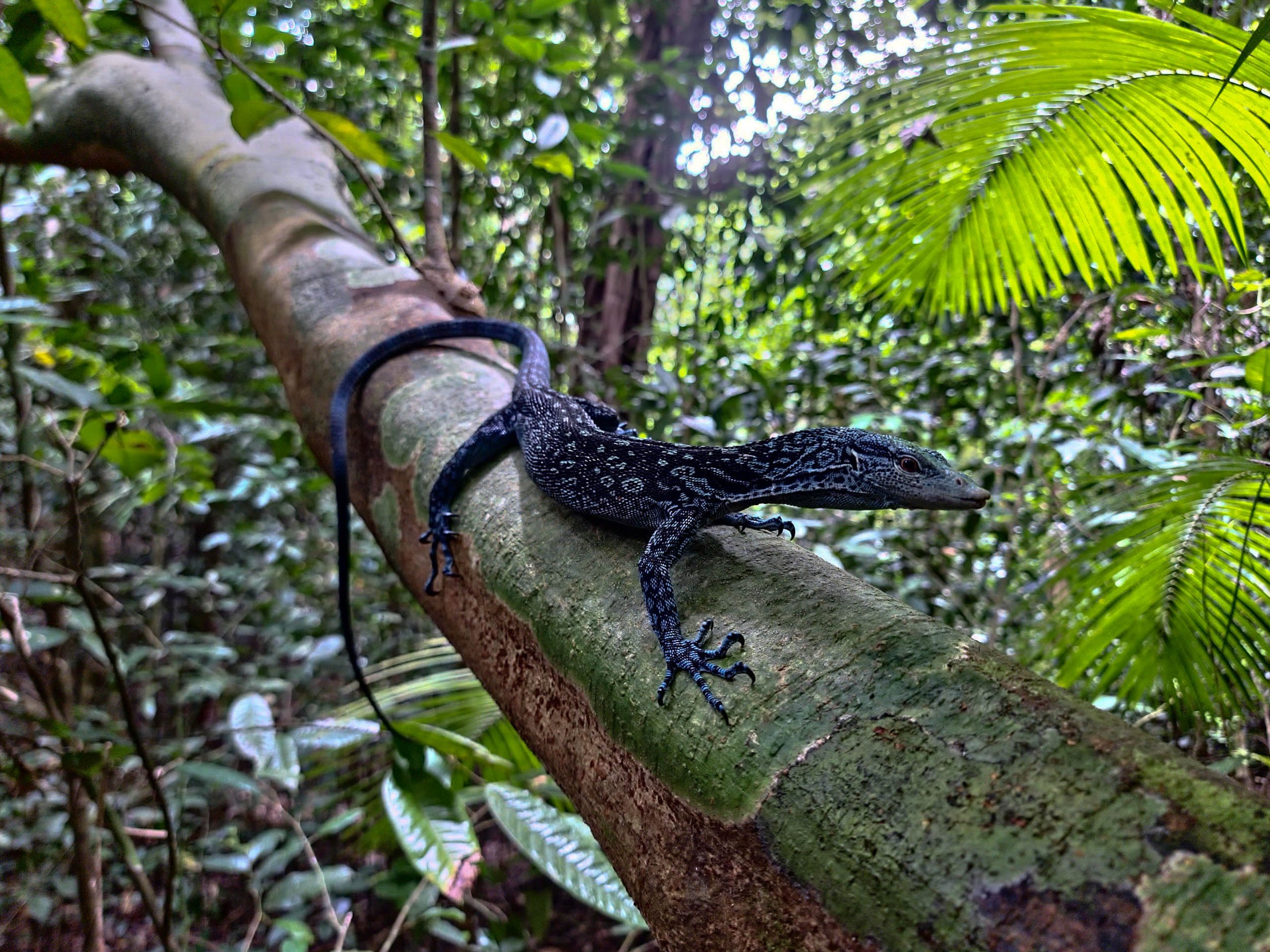
Ethics of harvesting wild animals
Removing animals from the wild to be placed into captivity can warrant highly emotional responses. Across the world, perspectives on wild-caught animals in the pet trade differ just as much as they do between societal groups and this can create polarised opinions on the matter. There is evidence to suggest that collecting wild animals gradually depletes populations, but there is also evidence to suggest that sustainable commerce protects wild populations over time. Some believe that removing an animal from the wild is inherently wrong while others believe that the successful reproduction of that animal in captivity will secure future generations of the species. Different opinions help encourage interesting debates and neither perspective should be considered entirely true nor false as conservation is a very complicated field. Indeed, many (if not most) herpetologists fighting to protect wild reptiles and amphibians maintain or have maintained animals in captivity before.
One thing that is certain is that humans are changing the face of the planet forever. According to Our World in Data, Indonesia loses over 500,000ha of rainforest each year. It is the second most deforested country in the world, trumped only by the enormous landmass of Brazil. In just one year, Indonesia could, theoretically, lose the entire distribution area of the blue tree monitor 11X over. While the ideal scenario is to simply “protect” wild places, this is often unmanageable and simply does not satisfy the capitalist agenda that most people on planet Earth live by. Instead, sustainability within commerce is necessary to incentivise the protection of wild spaces.
While eco-tourism is beginning to protect some areas of Indonesia, herpetology tours are typically in less demand than birding or scuba-diving excursions. This means that tourists visiting remote locations often have the opportunity to work with extremely knowledgeable herpetologists and local guides. Chris concludes: “Nurdin is the most instrumental guy over there. The trip would not have gone smoothly without him and he doesn’t seem to be mentioned enough. He guided the trip that led to the description of Varanus colei and was probably the first person to see macraei outside of the villages in Batanta. Of course, our hunters Edward and Petrus and boat captains Alwi and Alfajri were also instrumental in such a successful trip. I am keen to encourage more people to visit Batanta. The people of Raja Ampat and Batanta in particular are extremely friendly and welcoming and people can learn a great deal about the incredible animals that live there.”
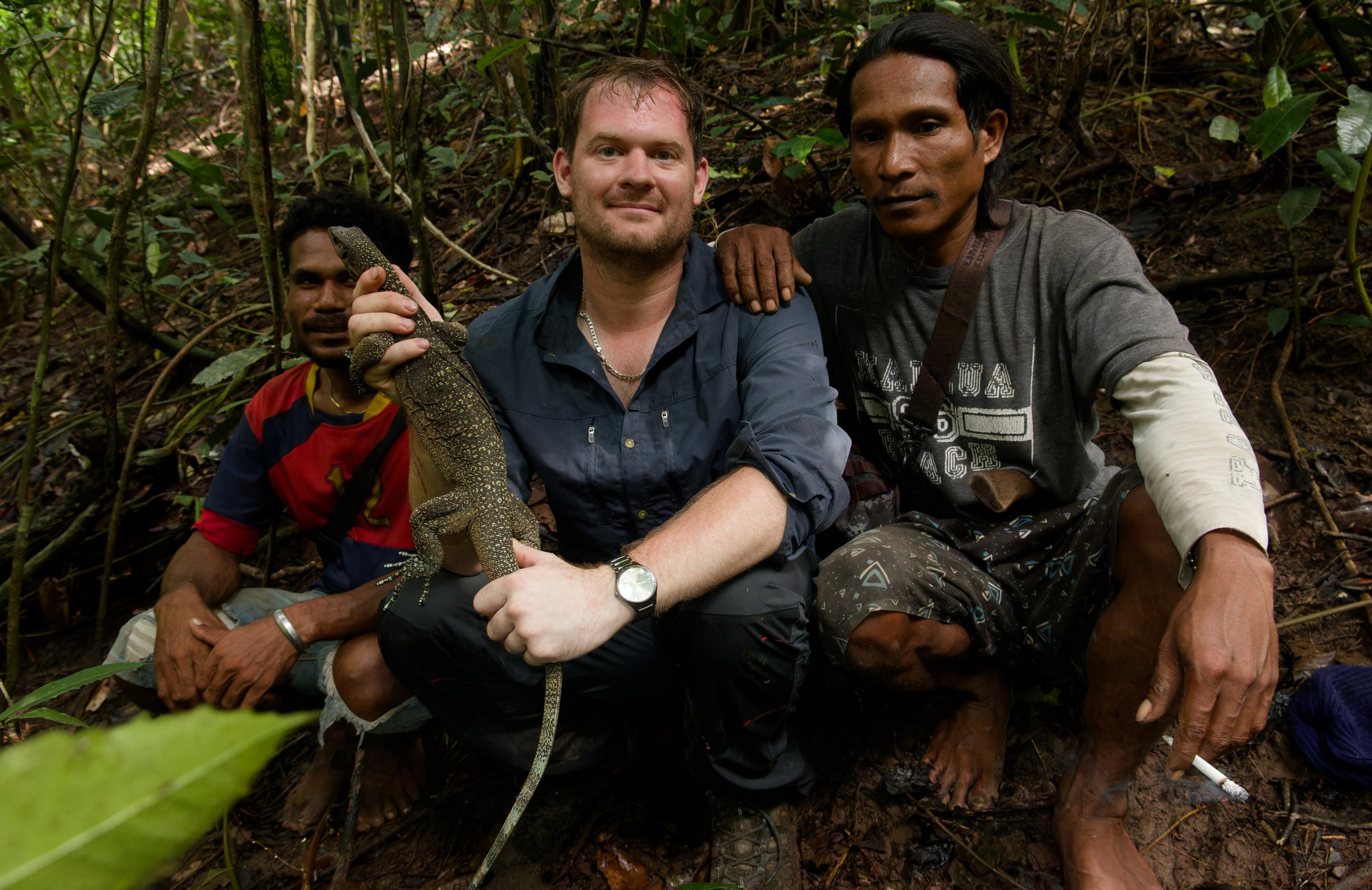
Readers can find out more about Chris’ future trips and UK breeding projects by visiting www.rarereptile.co.uk or following him on instagram @rarereptiles.
